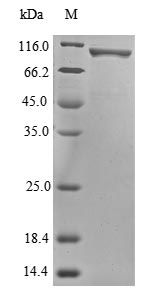Recombinant Severe acute respiratory syndrome coronavirus 2 Nucleoprotein (N), Biotinylated, is expressed in E. coli and covers the complete sequence spanning amino acids 1-419. The protein includes an N-terminal MBP-tag and a C-terminal 6xHis-Avi-tag, which appears to support diverse research applications. Purity reaches over 85% as confirmed by SDS-PAGE, though actual performance may vary depending on specific experimental conditions. This protein is designed strictly for research purposes and seems to provide a reliable foundation for scientific investigations.
The SARS-CoV-2 Nucleoprotein likely plays a central role in viral life cycle processes. It appears primarily involved in RNA genome packaging and ribonucleoprotein complex formation. Evidence suggests it's essential for viral replication and transcription, though the exact mechanisms remain an active area of study. Given these important functions, the Nucleoprotein has emerged as a key target for researchers working to understand coronavirus biology and develop new diagnostic or therapeutic strategies.
Potential Applications
Note: The applications listed below are based on what we know about this protein's biological functions, published research, and experience from experts in the field. However, we haven't fully tested all of these applications ourselves yet. We'd recommend running some preliminary tests first to make sure they work for your specific research goals.
The protein is expressed in E. coli, a system prone to producing misfolded proteins or inclusion bodies despite the N-terminal MBP tag (which typically enhances solubility and folding). While MBP improves solubility, there is no evidence of proper folding (e.g., circular dichroism for secondary structure, limited proteolysis for native conformation, or reactivity with conformation-specific antibodies) or retained bioactivity (e.g., binding to anti-N antibodies or interacting with native partners). The biotinylation is chemically functional but depends entirely on the protein’s correct tertiary/quaternary structure. Thus, the protein may be partially or fully folded, but its biological activity—critical for downstream applications—is unvalidated.
1. ELISA-based Binding Assays for Anti-SARS-CoV-2 Nucleoprotein Antibody Screening
This biotinylated nucleoprotein has potential as a capture antigen in ELISA but requires validation. The biotin tag enables consistent streptavidin plate immobilization, but E. coli-expressed proteins often misfold—researchers must first confirm antigenicity (e.g., using known positive anti-N antibodies) to ensure native epitopes are preserved. The full length could detect conformational/linear epitopes only if the protein folds correctly. It may aid monoclonal antibody studies, but results depend on protein quality.
2. Streptavidin-Based Pull-Down Assays for Protein-Protein Interaction Studies
Immobilizing this biotinylated nucleoprotein on streptavidin beads could explore interactions, but success hinges on native conformation. Misfolded protein will fail to bind native partners, even with stable biotin-streptavidin bonds. The MBP/His tags aid purification/detection but do not guarantee folding. Pull-downs may identify candidates, but physiological relevance requires follow-up (e.g., cell co-IP). Note: E. coli expression risks misfolding—verify folding before use.
3. Surface Plasmon Resonance (SPR) Studies for Kinetic Analysis
This protein could be used in SPR to measure binding kinetics, but only if correctly folded. The biotin tag may stabilize orientation, but misfolding will abolish or alter binding, yielding inaccurate data. While >85% purity and full length are favorable, structural integrity is unproven. Validate binding to known partners (e.g., anti-N antibodies) via SPR first—claiming it is "well-suited" is premature without folding/bioactivity data.
4. Immunofluorescence and Flow Cytometry Applications
Pairing this biotinylated protein with fluorescent streptavidin might work in cell assays, but utility depends on correct folding and epitope presentation. Misfolded protein may not be recognized by sample antibodies (leading to false negatives in IF) or alter the signal in flow cytometry. Additionally, E. coli-expressed protein may contain endotoxins (not mentioned), which interfere with cell experiments. Validate antigenicity and endotoxin levels before use.
5. Biochemical Characterization and Structural Studies
This full-length protein with dual tags could support biochemical studies (stability, oligomerization) if folded correctly. MBP aids solubility but does not guarantee native folding—some MBP-fused proteins still misfold. Structural studies (e.g., crystallography) require native conformation, which is unverified. As a reference standard for mutants/truncates, it works only if the wild-type protein is correctly folded—direct comparisons need functional validation. The statement "appears suitable" should include the caveat of unproven folding.
Final Recommendation & Action Plan
In summary, while the biotinylated SARS-CoV-2 N protein has potential for the described applications, its E. coli origin and lack of validated folding/bioactivity limit confidence. First, assess folding using circular dichroism (secondary structure), limited proteolysis (native state), or SPR (binding to conformation-specific antibodies). Next, validate bioactivity by testing reactivity with known anti-N antibodies (ELISA) or native interaction partners (co-IP). If folding/activity are confirmed, use the protein with caution—note limitations (e.g., E. coli expression) in publications. If not, refold (if inclusion bodies) or switch to a eukaryotic system for better folding. For all applications, include controls (e.g., unfolded protein) to account for conformational effects.






